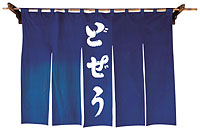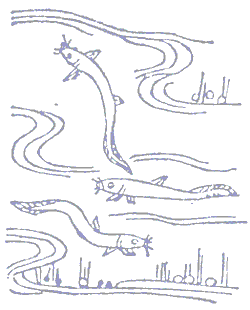Bon Appetit! Japanese Culture in the Kitchen
Dojo, called “loach” in English, are a freshwater fish that like deep muddy pools where the water flows slowly. They are only about 12 cm in length. Their skin is slippery and their bodies are slim, reminding one of an eel. And with what could pass for whiskers, their “faces” have a humorous look, setting them apart from other fish.
Years ago in Japan, lots were caught in streams and flooded rice fields, but farm pesticides and rural development projects have caused the natural dojo population to plummet, and over the last few years dojo have all come from fish farms or overseas.
The Japanese have eaten dojo since ancient times, and around the 17th to 19th centuries it was the most commonly eaten fish among the working class. A number of dojo recipes were developed in those days, and are still used today at Komagata Dojo in Tokyo's Asakusa district.
The restaurant, founded in 1801, will give you an authentic old-Edo experience, perhaps more authentic than any of the other several dojo specialty eateries that still exist in Tokyo. Slide open the outside wooden door and you will find yourself in a pub right out of the Edo period (1603-1867) with old-fashioned furnishings, zabuton cushions, tatami mats and low tables. The menu features tasty dishes like dojo-jiru (cleaned dojo simmered whole, then placed in a miso soup) and Yanagawa-nabe (beaten egg poured over thinly sliced burdock root and dojo that have been slit and spread open). But if you want to taste dojo at its best, retaining its original shape, I would recommend dojo-nabe.
Almost as soon as you order dojo-nabe, a small hibachi grill is brought to your table, with the charcoal already red-hot. Next comes the dojo, pre-cooked and neatly arranged in broth in a shallow pan. The pan goes on the grill. A box for seasonings, filled with lots of sliced green onion, is placed where it is convenient for you, together with a broth in an earthenware teapot. You finish cooking the meal yourself—toss the green onion on top of the fish and wait for everything to simmer until done. That will not take long, because the fish has already been pre-cooked. When the broth begins boiling merrily it is time to eat. Add some shichimi-togarashi (a ground spice mix of cayenne pepper, five other spice seeds, and dried orange peel) or Japanese pepper to taste, and more broth from the teapot when needed.
The simmered dojo is soft and will practically melt in your mouth, so you end up not worrying about eating even the bones and head. Many river fish have a distinctive taste people may find slightly unpleasant, but not dojo when cooked like this. The taste is light and unassumingly delicious. Unagi (eel), with which dojo is sometimes compared, has a stronger taste that goes well with rice, while the light flavor of dojo goes best with saké. Connoisseurs drink saké with the dojo-nabe, then finish everything off with rice and dojo-jiru made with a sweet miso paste.
Near the restaurant door, outside, stands an ornamental stone with this poem written on it:
Mikoshi matsu ma no
Dojo-jiru
Susurikeri
While waiting for the portable
shrine to come,
We sip our dojo soup,
And enjoy the festival.
The poet, Kubota Mantaro (1889-1963), was brought up here in Asakusa, and made his name through plays and haiku depicting the feelings of people in working class neighborhoods. A great number of people carry mikoshi portable shrines during Asakusa Shrine's Sanja Festival in mid-May. It is the beginning of summer, when spawning dojo have soft bones and are at their best for the table. ![]()

